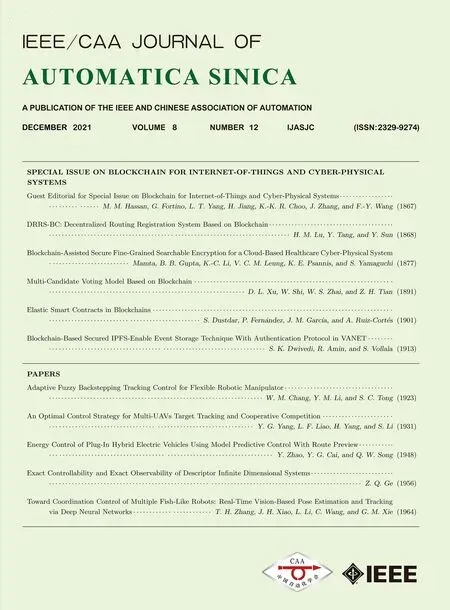Guest Editorial for Special Issue on Blockchain for Internet-of-Things and Cyber-Physical Systems
Mohammad Mehedi Hassan,,Giancarlo Fortino,,Laurence T.Yang,,Hai Jiang,Kim-Kwang Raymond Choo,,Jun Jason Zhang,and Fei-Yue Wang,
Cyber-physical systems (CPS) are increasingly commonplace,with applications in energy,health,transportation,and many other sectors.One of the major requirements in CPS is that the interaction between cyber world and man-made physical world (exchanging and sharing of data and information with other physical objects and systems) must be safe,especially in bi-directional communications.In particular,there is a need to suitably address security and/or privacy concerns in this human-in-the loop CPS ecosystem.However,existing centralized architecture models in CPS,and also the more general IoT systems,have a number of associated limitations,in terms of single point of failure,data privacy,security,robustness,etc.Such limitations reinforce the importance of designing reliable,secure and privacy-preserving distributed solutions and other novel approaches,such as those based on blockchain technology due to its features (e.g.,decentralization,transparency and immutability of data).This is the focus of this special issue.
In this editorial,we will present the research advances outlined in five accepted papers (after going through several rounds of reviews by subject matter experts),authored by researchers from Australia,Austria,Canada,China,Greece,India,Japan,and Spain.
In “DRRS-BC: Decentralized Routing Registration System Based on Bloc kchain”,the authors proposed a decentralized blockchain-based route registration framework-decentralized route registration system,which comprises a globaltransaction ledger.The blockchain-based system is also designed to support identity and behavior authentication.The authors then evaluated the security of their proposed system and showed that it resists prefix and subprefix hijacking attacks.
In “Blockchain-Assisted Secure Fine-Grained Searchable Encryption for a Cloud-Based Healthcare Cyber-Physical System”,the authors demonstrated how one can achieve secure fine-grained searchable encryption in a cloud-based heal thcare cyber-physical system using blockchain as the enabling technology.The authors also evaluated the security and performance of the proposed approach.
In “Multi-Candidate Voting Model based on Blockchain”,the authors proposed a blockchain-based multi-candidate voting model,which also utilizes asymmetric encryption and an anonymity-preserving voting algorithm to support real-time voting result display.The authors then attempted to evaluate the scalability of the proposed model.
In “Elastic Smart Contracts in Blockchains”,the authors focused on the application of blockchain in complex Internet of Things (IoT)-based ecosystems,prior to explaining how their proposed elasticity concept can be applied in such a setting.
In “Blockchain-based Secured IPFS-Enable Event Storage Technique with Authentication Protocol in VANET”,the authors revealed weaknesses in their previously proposed blockchain-based event sharing protocol and explained how several of these weaknesses can be mitigated in an improved design,also leveraging the interplanetary file system (IPFS).They then evaluated the performance of the improved protocol.
Now that we have introduced the five accepted papers,we would like to offer our gratitude to the subject matter experts for their time and efforts in reviewing the manuscripts and offering constructive feedback,and also to the authors for submitting their manuscripts to this special issue for consideration.We are also grateful to Dr.Mengchu Zhou,the Editor-in-Chief of theIEEE/CAA Journal of Automatica Sinica,and the journal staff (e.g.,Dr.Yan Ou) for their support in this special issue.
 IEEE/CAA Journal of Automatica Sinica2021年12期
IEEE/CAA Journal of Automatica Sinica2021年12期
- IEEE/CAA Journal of Automatica Sinica的其它文章
- Toward Coordination Control of Multiple Fish-Like Robots: Real-Time Vision-Based Pose Estimation and Tracking via Deep Neural Networks
- Exact Controllability and Exact Observability of Descriptor Infinite Dimensional Systems
- Energy Control of Plug-In Hybrid Electric Vehicles Using Model Predictive Control With Route Preview
- An Optimal Control Strategy for Multi-UAVs Target Tracking and Cooperative Competition
- Adaptive Fuzzy Backstepping Tracking Control for Flexible Robotic Manipulator
- Blockchain-Based Secured IPFS-Enable Event Storage Technique With Authentication Protocol in VANET
